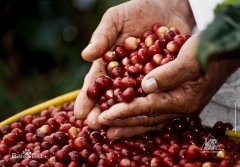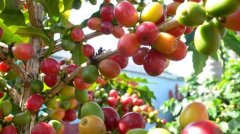Coffee beans-country of origin and name
Brazil
Coffee beans
Atlas of coffee beans in Brazil
Brazil is the most important coffee producing area in the world, accounting for 1x3 of the total output in the world. Brazil has 10 states producing coffee beans. Due to differences in region and climate, the quality of Brazilian coffee beans is inevitably intermingled. Therefore, Brazilian coffee beans are divided into No.1-No.3,Screen 18 and screen 19 according to the grade, so that the quality is neat and stable, and the processing and roasting can also have a better effect. Brazilian coffee is medium-fragrant, sour and mellow, has a mild bitter taste and is famous for its smooth taste. Among all kinds of Brazilian coffee varieties, Santos Coffee is more famous. Santos Coffee can also be called Bourbon Santos. Bourbon Santos is of good quality and has a round taste with moderate acidity and strong sweetness. Bourbon Santos is considered to be an indispensable ingredient for mixed coffee.
Blue Mountain
Blue Mountain Coffee is produced in the Blue Mountains of western Jamaica, hence its name. Blue Mountain is a mountain range with an elevation of 2256 meters. Coffee trees are planted on a steep hillside about 1000 meters above sea level. The annual output of Blue Mountain Coffee is only about 700 tons. Blue Mountain coffee beans are full in shape and slightly bigger than ordinary beans. Sour, fragrant, mellow, sweet taste is uniform and strong, slightly bitter taste, harmonious taste, excellent flavor, suitable for individual coffee. Due to the low output, most of the products sold on the market are "special blue mountains", that is, mixed coffee with other coffee beans at the bottom of the blue mountains.
Colombia
Colombia is the second largest coffee producer in the world, accounting for 12% of the world's total output, second only to Brazil and the largest producer of Colombian Mild. Colombian coffee trees are planted in the highlands and have a small cultivated area in order to take care of harvesting. The harvested coffee beans are refined with water washing (wet method). Colombian coffee beans are of neat quality and can be called the standard beans among coffee beans. Colombian coffee beans are large in shape, light green, with a special thick flavor, and are widely favored for their rich and unique aroma. The taste is sweet in the acid and low in bitterness, which can lead to multi-level flavor with the different degree of baking. Medium baking gives full play to the sweetness of beans, with mellow acidity and bitterness; deep baking increases bitterness, but the sweetness still doesn't disappear much. Generally speaking, medium-deep roasting will make the taste more personalized, not only as a single drink, but also suitable for mixed coffee.
Manning
Indonesia is a big coffee producer. Coffee is mainly produced in Java, Sumatra and Sulawi, with ROBUSTA species accounting for 90% of the total production. Manning is one of the few Arbica species. The granule of Mantenin is large, the bean quality is very hard, and the rate of defects in the planting process is on the high side, which is usually selected manually after harvest. If the control process is not strict enough, it is easy to cause a mixture of good and bad quality, and different baking degrees also directly affect the taste. Therefore, it has become a more controversial single product. Before Blue Mountain was discovered, Manning was regarded as the best coffee because of its rich and mellow taste, not astringent but not sour, mellow and bitter; moderate roasting will leave a moderate sour taste and unique flavor; if the roasting is too shallow, it will be powdery and astringent.
Kona.
Hawaiian coffee beans are grown on volcanic terrain. At the same time, there is a high density of artificial farming, so each bean can be said to be spoiled, the price is naturally expensive, second only to the Blue Mountains. Hawaiian Kona beans are evenly shaped and have a strong sour and sweet taste. The palate is moist and smooth. Moderate baking makes beans sour, while deep baking aggravates both bitterness and mellow taste. This coffee bean grows from sea level to 6000 feet. Gourmet coffee generally grows only in mountain areas, growing at a height of about 4000 to 6000 feet requires annual rainfall of about 80 feet and is obvious in dry and wet seasons. The soil for growing gourmet coffee beans should be very fertile and usually have volcanic rock, and light cloudy or cloudy weather is also necessary in the growing environment of high-quality coffee beans. The daytime temperature needs 15-20 °C. This climate results in a longer growth process, a unique growth and climatic environment that leads to a stronger coffee flavor.
Production method
After harvest, peel, pulp, racing peel and silver peel should be removed before shipping and listing. There are two kinds of methods: drying (also known as natural or non-washing) and washing.
Dry type
The method is relatively simple. First of all, spread the freshly harvested fruit on the sun field for a week or two until the fruit crackles and dries naturally. After that, the dried pulp, endocarp and silver peel are removed by a sheller.
Coffee beans refined in this way are slightly sour and slightly bitter. Almost all coffee beans produced in Brazil, Ethiopia, Yemen and other places are obtained in this way. The disadvantage of this method is that it is easily affected by the weather and is easy to be mixed with defective beans and other impurities. Therefore, it must be carefully screened.
Washing type
The fruit that is about to be harvested is put into a flowing trough. After the floating fruit is removed, the skin and flesh are removed by a pulp remover. Then put it in the sink to remove the emerging pulp. After that, move into the fermentation tank, soak for half a day to a day, and then dissolve the gum on the surface of the fermented coffee beans.
After washing with water, drying it for a few days, drying it with a machine, and finally using a sheller to remove the endocarp to become a commercial raw coffee bean. In this way, it will be more beautiful in color and less impurity than dried coffee beans. Colombia, Mexico, Guatemala and other countries use this method for about 70% of their production.
Mode comparison
The coffee beans are treated after harvest, otherwise they will begin to ferment, making the coffee beans smell bad. The main treatment methods are "drying" and "washing", these two methods will cause different flavors. Dry beans have complete natural mellow taste, gentle aroma and more gum, while water washing has good mellow taste, high aroma and lively sour taste, which is also the source of sweetness in espresso.

Important Notice :
前街咖啡 FrontStreet Coffee has moved to new addredd:
FrontStreet Coffee Address: 315,Donghua East Road,GuangZhou
Tel:020 38364473
- Prev

Arabian coffee with small quantity, high quality and soft taste in the Democratic Republic of Sao Tome and Principe
Sao Tome and Principe Democratic Republic of Sao Tome and Principe (Sao Tom and Principe), a volcanic archipelago, is the second smallest independent country in Africa and a former Portuguese colony, which did not win its independence until 1975. The equator crosses the archipelago, where the climate is hot and humid, the land is fertile and irrigated
- Next

South Africa is fragrant with less acidity, reminiscent of Central American coffee beans
South Africa is fragrant with less acidity, reminiscent of Central American coffee beans. Coffee production in South Africa (South Africa) is mainly in the northeast of the country, from Natal between Transvaal and Mozambique, extending northward to Transvaal, with a southernmost limit of latitude 30 south. Further south, it cannot be caused by early frost.
Related
- Does Rose Summer choose Blue, Green or Red? Detailed explanation of Rose Summer Coffee plots and Classification in Panamanian Jade Manor
- What is the difference between the origin, producing area, processing plant, cooperative and manor of coffee beans?
- How fine does the espresso powder fit? how to grind the espresso?
- Sca coffee roasting degree color card coffee roasting degree 8 roasting color values what do you mean?
- The practice of lattes: how to make lattes at home
- Introduction to Indonesian Fine Coffee beans-- Java Coffee producing area of Indonesian Arabica Coffee
- How much will the flavor of light and medium roasted rose summer be expressed? What baking level is rose summer suitable for?
- Introduction to the characteristics of washing, sun-drying or wet-planing coffee commonly used in Mantenin, Indonesia
- Price characteristics of Arabica Coffee Bean Starbucks introduction to Manning Coffee Bean Taste producing area Variety Manor
- What is the authentic Yega flavor? What are the flavor characteristics of the really excellent Yejasuffi coffee beans?

